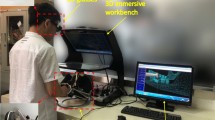Abstract
This paper treats the improvement of the dental treatment training system proposed by the authors. Dental course students have to pay much money for their dental treatment training because the training needs expensive dentures that are discarded after that. If dental course students can use a training system that provides teeth as 3D CG models virtually, they can reduce their training costs drastically because such 3D CG models can be used repeatedly and there are not any physical losses. Therefore, the authors have already proposed a dental treatment training system using a haptic device called Phantom that works as a dental drill. In this first system, the polygonal mesh subdivision was adopted for making a accurate shaved tooth shape. However, there were several problems so that the authors proposed new system that solved these problems. Indeed, there were still other problems in this previous system. In this paper, the authors also propose new system that solved these previous problems. This paper describes how the authors improved the system and also shows evaluation results by three dental course students to justify the improvement.
Access this chapter
Tax calculation will be finalised at checkout
Purchases are for personal use only
Similar content being viewed by others
References
Kosuki, Y., Okada, Y.: 3D visual component based development system for medical training systems supporting haptic devices and their collaborative environments. In: Sixth International Conference on Complex, Intelligent and Software Intensive Systems (CISIS-2012), pp. 687–692 (2012)
Okada, Y., Tanaka, Y.: IntelligentBox: a constructive visual software development system for interactive 3D graphic applications. In: Proceedings of Computer Animation 1995, pp.114–125 (1995)
Okada, Y., Tanaka, Y.: Collaborative environments of IntelligentBox for distributed 3D graphic applications. In: Proceedings of Computer Animation 1997, pp. 22–30 (1997)
Kosuki, Y.: Study on development environment of medical learning support system using a haptic device. Master’s thesis, Graduate School of ISEE, Kyushu University (in Japanese), February 2014
Nomi, M., Okada, Y.: Improvement of dental treatment training system using a haptic device. In: Proceedings of the 15th International Conference on Broad-Band and Wireless Computing, Communication and Applications, BWCCA 2020, pp.143–153
Escobar-Castillejos, D., Noguez, J., Neri, L., Magana, A., Bnes, B.: A review of simulators with haptic devices for medical training, pp. 6–9 (2016)
Tse, B., Harwin, W., Barrow, A., Quinn, B., San Diego, J., Cox, M.: Design and development of a haptic dental training system - hapTEL. In: Kappers, A.M.L., van Erp, J.B.F., BergmannTiest, W.M., van der Helm, F.C.T. (eds.) EuroHaptics. LNCS, vol. 6192, pp. 101–108. Springer, Heidelberg (2010). https://doi.org/10.1007/978-3-642-14075-4_15
Si, H., Tetgen. http://wias-berlin.de/software/tetgen/. Accessed 15 July 2020
Chen, X., Lin, Y., Wang, C., Shen, G., Wang, X.: A virtual training system using a force feedback haptic device for oral implantology. In: Pan, Z., Cheok, A.D., Müller, W., Chang, M., Zhang, M. (eds.) Transactions on edutainment VIII. LNCS, vol. 7220, pp. 232–240. Springer, Heidelberg (2012). https://doi.org/10.1007/978-3-642-31439-1_21
Hui, Z., Dang-xiao, W.: Soft tissue simulation with bimanual force feedback. In: International Conference on Audio Language and Image Processing (ICALIP), pp. 903–907 (2010)
Moog Simodont dental haptic trainer
Welk, A., et al.: DentSim-a future teaching option for dentists. Int. J. Comput. Dent. 7(2), 123–130 (2004)
Plessas, A.: Computerized virtual reality simulation in preclinical dentistry: can a computerized simulator replace the conventional phantom heads and human instruction? J. Soc. Simul. Healthcare 12(5), 332–338 (2017)
SensAble technologies.. https://www.3dsystems.com/haptics. Accessed 5 July 2020
Loop, C.: Smooth Subdivision surfaces based on triangles. Master ’s thesis, University of Utah, Department of Mathematics (1987)
Author information
Authors and Affiliations
Corresponding author
Editor information
Editors and Affiliations
Rights and permissions
Copyright information
© 2022 The Author(s), under exclusive license to Springer Nature Switzerland AG
About this paper
Cite this paper
Nomi, M., Okada, Y. (2022). Dental Treatment Training System Using Haptic Device and Its User Evaluations. In: Barolli, L. (eds) Complex, Intelligent and Software Intensive Systems. CISIS 2022. Lecture Notes in Networks and Systems, vol 497. Springer, Cham. https://doi.org/10.1007/978-3-031-08812-4_55
Download citation
DOI: https://doi.org/10.1007/978-3-031-08812-4_55
Published:
Publisher Name: Springer, Cham
Print ISBN: 978-3-031-08811-7
Online ISBN: 978-3-031-08812-4
eBook Packages: Intelligent Technologies and RoboticsIntelligent Technologies and Robotics (R0)




